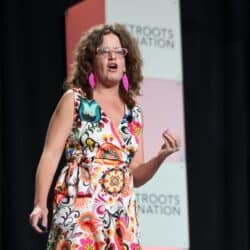Changing the way people think about an issue is a precondition to mobilizing action on it. But which organizations have institutionalized narrative change practices as a strategic priority, and how is that playing out day-to-day? How many non-profits are doing the deep listening necessary to understand how audiences perceive their issues, and developing strategic messaging that can shift the conversation?
In 2019, Sadia Zaman, then a new CEO at the Inspirit Foundation, pressed pause on day-to-day operations to engage her team in a reflection on the organization’s mission.
Inspirit was founded in 2012 with funds from the sale of VisionTV and a mission to promote inclusion and pluralism through media and arts, support for young change-makers, and impact investing. What could the foundation do through its funding activities, Zaman asked her team, to achieve more systemic change?
The answer that emerged was to deepen the foundation’s commitment to shifting narrative power to under-heard groups so they can reframe problematic narratives that stand in the way of meaningful change.
Inspirit started by strengthening its support of Indigenous narrative sovereignty by shifting a bigger share of funding to Indigenous-led, instead of Indigenous-informed, organizations.
In summer 2022, the foundation launched its Narrative Change Lab, which is handing the mic to 17 content creators to imagine what Muslim popular narratives would look like if they were developed by Muslims, instead of by others about Muslims.
“Since the beginning of the country, there has been Muslim presence in Canada. But often the narrative is that Muslims are from other places. Or that they’re a threat,” says Zaman. “A lot of these perceptions are fomented by popular culture. So the intervention has to come at the pop culture level.” The creators hope using mass culture tactics will help them spark a new public conversation about what it means to be Muslim in Canada.
Changing narratives in a changing world
Inspirit is one of a handful of Canadian social change–focused non-profits and foundations that are thinking about the role of narrative change and power in their work. The foundation believes that broad-scale change can’t happen if the people in power are the ones controlling the narrative. Shifting narrative power to communities that are often stereotyped and depicted from a place of deficit is necessary to achieve the social change they seek.
The idea of narrative change is not new – political strategists and marketers deploy frames and narratives to capture votes and pocketbooks as a matter of course. But while there are terrific examples of organizations and social movements that have shifted public conversation on issues – the Defund the Police and trans rights movements are two that are top of mind right now – it is something of an emerging area of work in our sector. We accept the idea that changing the way people think and talk about an issue is a precondition to mobilizing action on it. But which organizations have institutionalized narrative change practices as a strategic priority, and how is that playing out day-to-day? How many non-profits are doing the deep listening that’s necessary to understand how their audiences perceive their issue, and developing strategic messaging that can shift the conversation?
Every organization needs to get a heck of a lot better at communicating. And that doesn’t mean broadcasting out: that means truly communicating, listening, and finding ways to engage.
Sean Gibbons, The Communications Network
The need for expertise in narrative action has become more pressing. We live in a rushing stream of information and ideas. Public conversation moves at lightning speed, and it can be a challenge just to keep up with shifts in opinion and perspective, let alone break through with a message or lead the conversation. At the same time, for many trying to make progress on pressing social issues, the pace of change can feel glacial. No matter how much or how intentionally you communicate about your issue, it often feels like you’re bashing up against the same prevailing narratives and frames that further entrench ingrained beliefs and hinder meaningful progress. The growing blurring of fact and fiction further complicates things.
“We’re very fortunate in some ways to be living in this really extraordinary time where information has become the most important currency on the planet,” says Sean Gibbons, head of Washington, D.C.–based non-profit The Communications Network, which has members from across the U.S. and Canada. “[But that means that] every organization needs to get a heck of a lot better at communicating. And that doesn’t mean broadcasting out: that means truly communicating, listening, and finding ways to engage.”
Climate change is an issue that’s a battleground of competing narratives and beliefs. To try to break through the fatalism and politicization that prevent action, The Trottier Family Foundation recently launched a call for creators who can develop content that disrupts and dismantles false or harmful narratives. The foundation noted Melbourne-based The Juice Media’s satiric Honest Government Ads campaign as an example of what it’s after. Understanding that an obstacle to action was the Australian public’s mistrust of government’s intentions, the Juice’s campaign cast the voting public as the protagonist that must hold the lying and obfuscating government antagonist to account, and used humour to break up complacency, changing the narrative from “The government is all talk and no action” to “We’re angry and we have a role to make government act.”
Defining narrative change
OK, but what exactly is narrative change? It can seem like something that’s happening all the time and not at all – a somewhat vague process with indeterminate outcomes.
The team at Washington, D.C.–based FrameWorks Institute has done a lot of thinking on the subject. Their technical definition of narrative is a set of common elements (e.g. character, setting, and point of view) and themes that both cut across stories and shape them. Narratives are informed by and inform our values, mindsets, and beliefs. Essentially, they’re the stories we tell ourselves about who we are and how we act as individuals and a society.
Some narratives are so “sticky” they move through society like air, their provenance unknown and validity often unquestioned. The bootstraps narrative tells us that anyone can succeed if they try hard enough. A dominant immigration narrative tells us that newcomers are a drain on the system and take resources and opportunities away from deserving citizens.
Narrative change work is all about identifying the dominant narratives that affect people’s beliefs and action on your issues and developing modified or counter-narratives that can change mindsets and conversations and fuel action.
Narratives change over time, gaining or losing volume and shifting focus. The blame-the-victim narrative, which says that a woman who has been sexually assaulted did something to cause the assault, has been entrenched since the Middle Ages at least. The system-is-rigged narrative, which communicates that governments and institutions exist to uphold the rights and privileges of the few, not the many, is by no means new but has taken on new volume and urgency in the mainstream in recent years.
Narrative change work is all about identifying the dominant narratives that affect people’s beliefs and action on your issues and developing modified or counter-narratives that can change mindsets and conversations and fuel action.
In Canada, activists and academics in the food insecurity space have fought for years against the prevailing beggars-can’t-be-choosers narrative, which says that people who need help should be grateful for any handout they get, with two counter-narratives: a rights-based narrative, which says that every Canadian has a right to access adequate and appropriate food, and that it’s government’s role to secure and fulfill that right; and a food-can’t-solve-hunger narrative, which says hunger can be alleviated only by increasing people’s incomes and addressing structural inequality that keeps people in poverty, not by donating food. These counter-narratives have gained some traction among media, decision-makers, and the public over the years through sheer repetition and thanks to progress in other rights-based and anti-racist movements.
Many following the abortion rights battle in the U.S. will have read about the pro-choice campaign’s big win last August. Kansans turned out in record numbers to vote on a ballot initiative that promised to restrict women’s right to abortion in the red state. In a surprise twist, the pro-choice campaign won by a landslide, responding to a narrative deployed by that campaign that the state and lawmakers have no business making decisions about women’s wombs. While pro-choice campaigns across the country have cleaved to a strong “abortion is healthcare” message, the Kansas campaign bet that this broader, values-based narrative would allow them to capitalize on dominant anti-vaccination sentiment and draw people into a bigger tent around a divisive issue, even if it risked alienating some in the movement. They were right.
The FrameWorks Institute has developed practical resources that help users map out the elements of the prevailing narratives affecting their issues and develop counter-narratives, bringing clarity and concreteness to abstract ideas. When you apply their narrative mapping tool to the food insecurity issue, for example, both counter-narratives shift the role of the protagonist to government, and the setting where change can happen from that of the fundraising sphere to the policy arena. By providing a structured process, the tool helps users think through which elements need to be in place for the narrative to resonate with intended audiences, which channels will be most effective in delivering the narrative, and which voices will most effectively carry it.
There’s a structural problem inside of our sector in that communications has not been seen as a strategic lever for change.
Sean Gibbons
When considering how to make change and advance their missions, foundations and non-profits need to be thinking about the narratives and frames they’re using to talk about the deeply entrenched problems they’re working on, and build up the skills to consistently and effectively deploy those messages. It needs to be a whole-of-organization effort that’s embraced by leadership and institutionalized in strategy. And it requires leadership and expertise from communications staff.
“There’s a structural problem inside of our sector in that communications has not been seen as a strategic lever for change. It’s quite evident that communications is having a profound influence on the way people perceive and act in the world,” says Gibbons. “We think the entire field needs to get much better at its work and much more effective at its work in order to really see some of the significant shifts and changes that many foundations and non-profits are working towards.”
Narrative change in practice
Toronto’s Holland Bloorview Hospital, which serves children with disabilities and complex medical needs, shows what it looks like to take a sustained and intentional approach to narrative change. The hospital explicitly included “leading and modelling social change” as a priority in its No Boundaries strategic plan for 2017 to 2022. One of the ways it has activated that priority is through its multi-channel Dear Everybody campaign, which challenges prevailing ableist narratives.
“Our mission is to create the most meaningful and healthy futures for all children, youth, and families. For us and for kids with a disability, stigma is one of the biggest barriers to creating this type of future,” says Ashleigh Saith, VP of public engagement. “It’s important for us to take the lead when it comes to changing hearts and minds about disability. Our goal is to advance the awareness that acceptance of disability and disability itself is a facet of diversity that makes all of us unique.”
The Dear Everybody campaign has proposed a series of counter-narratives, all informed by and developed with the input of children at the hospital. In its first year, the hospital shifted narrative power to children and youth, amplifying their voices through a letter-writing campaign in which they shared what they thought people should know about them and their disability.
The hospital has continued to facilitate workshops and jam sessions with kids and their families to hear directly about what matters most to them. And while campaign tactics and channels have shifted from year to year, there’s a consistent measurement and evaluation plan in place that measures shifts in public awareness and opinion.
Measuring progress and success isn’t a simple task. Narrative change work is not done in a vacuum, so meaningful contributions can be difficult to quantify. Shifts in narrative can sometimes come out of the blue, driven by chance or opportunism, or take so long to come about that the original drivers are no longer involved. But, as Saith knows, developing ways to measure shifts is critical to making the case for investment in the work.
Urgent problems with complex solutions
The Maytree Foundation has made a strategic decision to take a human rights approach to housing. Its advocacy and strategic communications on the issue focus on raising awareness that access to affordable and adequate housing is a human right that must be upheld by government. Deploying a rights-based narrative with stakeholders is key to delivering on its goals.
“There’s a really strong narrative that housing is a commodity, as opposed to our right,” says Bonnie Mah, strategic narrative lead at the foundation. “If we think that housing is a human right, then it’s not about its real estate value, it’s about the value to human beings to have a decent place to live, and that the government has a duty to contribute to that adequate standard of living.”
Figuring out which frames are most effective, and which tactics, channels, and voices will best carry the message – how to actually do the work – is always a work in progress.
Bonnie Mah, Maytree Foundation
Maytree’s organizational commitment to changing narratives on housing and poverty is long-standing, but Mah says figuring out which frames are most effective, and which tactics, channels, and voices will best carry the message – how to actually do the work – is always a work in progress.
One strategy that the FrameWorks Institute proposes is to expose the ridiculousness of the dominant narrative. Putting into question the widely held notion that only people with money deserve to have a roof over their heads could open up an opportunity to introduce a narrative that says that every person has a right to safe, adequate, and affordable housing.
The documentary Push profiles housing activist Leilani Farha’s quest, in her role as the UN Special Rapporteur on the Right to Adequate Housing, to investigate the impacts of the financialization of housing on people, and create The Shift, a right-to-housing movement. In the documentary, Farha repeatedly wonders how to frame the complex issue in a way that will capture stakeholders’ attention and drive the shift in the conversation that’s needed to lead to action. These moments capture narrative change in action and in all of its complexity as Farha tries to imagine and describe a different way forward on housing without the benefit of many positive examples to point to.
What’s next
In 2018, the Stanford Social Innovation Review published a series called Picture This: How We Frame Issues Matters for Social Change, co-authored by the FrameWorks Institute’s Nat Kendall-Taylor and Gibbons of The Communications Network. The series identified a handful of intractable issues, from ageism to gun rights, and profiled non-profits that were shifting narratives that were hampering meaningful progress on those issues. The series gave readers a peek at the strategic decisions organizations were making around narrative.
In the coming months, we hope to speak with people working on narrative change across Canada to find out more about what the work looks like at both a strategic and tactical level at their organizations, and what questions are emerging. How can the sector encourage and support organizations to build capacity around narrative change work, and where should the investment be made? How can organizations who don’t have this work in their DNA and strategic plans get started? And for those that do, how do you go from theory to practice?
If you’re engaged in narrative change work, know of examples that can provide effective roadmaps for future change, or have questions or thoughts, we want to hear from you. Please email us at info@thephilanthropist.ca or connect with us on social media at @Phil_journal.
Narrative change resources
- The Features of Narratives, FrameWorks Institute
- FrameWorks Academy
- Picture This: How We Frame Social Issues Matters for Social Change, Stanford Social Innovation Review
- The Narrative Initiative
- Funding Narrative Change, Convergence Partnership
- Measuring Narrative Change, Ors Impact
- Color of Change


